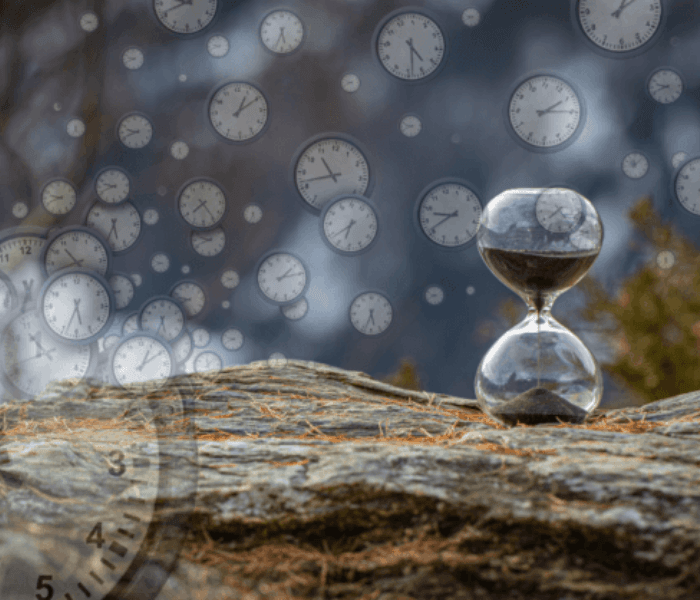Disclaimer: This article is for informational purposes only and is not intended as scientific or medical advice.
Can we reverse time? Explore how human perception, memory, and consciousness affect our understanding of time, and whether time reversal is more than just science fiction. Ever wish you could hit rewind on life like a movie? Go back, fix a mistake, relive a perfect day, or just avoid saying something you immediately regretted? Yeah, we all have. Time has always been this elusive, unstoppable force we’re painfully aware of but utterly powerless against. Or are we?
“Can we reverse time?” isn’t just a question reserved for scientists and sci-fi writers anymore. It’s something many ponder in silent moments when life races by in a blur or when wedged within recollections they wish they could rewrite. But what if time isn’t what we think it is? What if our perception of time—of past, present, and future—is just a trick our brain plays? And more importantly, if we could change how we perceive time, would that be a kind of reversing time in itself?
Let’s take a deep, slightly mind-bending dive into time—how we see it, what it really is, and whether there’s any hope of going back.
What Is Time, Really?
Time is everywhere, yet nowhere. We live by it—seconds, minutes, years—but try to define it, and things get fuzzy real quick.
In physics, time is considered the fourth dimension. It’s not something that just “passes.” It’s part of the fabric of the universe, just like length, width, and height. Einstein showed us that time is relative—it slows down or speeds up depending on how fast you’re moving or how much gravity you’re near (NASA, 2022). Time travel into the future? Technically possible. Time travel into the past? Trickier.
But Then… What About Our Perception?
Here’s the thing: humans don’t experience time like a ticking clock. We feel time. We notice it when we’re waiting too long. It is remembered when we think back on the greatest or the most terrible time’s in human life. And that makes it subjective. For example:
- A boring lecture feels like an eternity.
- A joyful vacation passes in the blink of an eye
.If time is so tied to emotion and memory… could our perception of it be manipulated?
Time and Human Consciousness
Let’s get philosophical (and a bit psychological). Human consciousness doesn’t live in the past or future—it lives in the present moment. Everything we know about time—memories, predictions, plans—is happening right now, in our minds.
The Brain as a Time Machine
Neuroscientists have found that different parts of the brain are responsible for processing past experiences and imagining future ones—and they often overlap. This is why thinking about a past event and imagining a future one can feel strangely similar(Harvard Medical School).The hippocampus, for instance, helps us both recall events and construct future scenarios. This isn’t just cool—it’s foundational to how we live.
Can We Really “Reverse” Time?
In Physics? Not Yet
While sci-fi stories imagine reversing time through futuristic technology, our understanding of physics suggests time only moves in one direction. Entropic processes like aging and decay demonstrate an arrow of temporal increase known as the thermodynamic arrow of time. Though symmetrical equations allow motion forward or backward, entropy seems to grow ever higher in reality. There exists no means currently to rewind the clock of the universe or freshly conjure shattered remnants.
In Your Mind? Possibly
However, our experience of the past lies within our minds, not solely defined by external events. Through practices altering recollection like memory reconsolidation, therapeutic interventions, mindfulness and visualization techniques, one can reshape remembrances of bygone days. Emotionally if not factually, we possess potential to revisit and even rescript our personal histories. Relatedly, how our thoughts sculpt perceived reality indicates a mental gateway toward remodelling relationships with the past.
Related: The Mind’s waves – How Our Thoughts Shape Our Reality.
Memory Isn’t a Recording—It’s a Remix
Commonly said yet only partly true, “time heals all wounds” depends more on wound processing than mere passage. What really mends traumas transpiring internally through memory. With each recall, the brain reconstructs rather than replays memories. Like editing stored files, emotional state, evolving beliefs and dialogues can variably colour recollections. While external occurrences remain fixed, one controls the interior narratives recited. This explains how some people find solace reconciling with even very painful prior eras.
Others remain trapped dwelling on minutes that no further subsist Rewriting your relationship with the passing of time is one of the most mighty gifts given to humankind—and it takes place solely within our minds.
Future Time Travel Is Technically Real
Forward time travel is scientifically plausible. While returning to previous eras stays theoretical at finest, propelling into coming moments is something people indeed understand.
How It Works
The concept functions thusly: should you journey at speeds approaching that of light, the flowing of time would decelerate for you contrasted to those staying on Earth. You may only age a handful of months whereas years pass elsewhere(Scientific American). It’s real scientific theory, not simply fictional shows. Yet attaining such speeds remains an overwhelming challenge (besides owning a spacecraft and relishing the emptiness of space).
Learn more:- NASA’s article Is Time Travel Possible?
Even quantum experimentation hints at reversing time’s arrow. In 2019, scientists manipulating a quantum computer momentarily switched a particle’s state – demonstrating time reversal may occur at that level, where nature diverges from classical laws.
You can learn more regarding that experiment in this Nature article. But bringing such an impact into the real world stays tremendously beyond our present technologies.
Regardless of our constraints, the yearning to turn back time regularly stems from emotional reasons—regret, loss, or reminiscence. While we may not have the ability to return and alter the past, we can still use what we’ve realized to design the forthcoming.
Can Perception of Time Be Trained?

Unlock the Magic of Time Perception
Techniques to Enhance Your Time Perception
Discover unique methods that may not alter time itself but will surely revolutionize how you perceive it:
1. Embrace Mindfulness Meditation
Immerse yourself fully in each fleeting present moment to slacken the pace of time’s passage. Delve into the intricacies of each instant, uncovering hidden details that often go unnoticed.
2. Dive into Flow States
Engage in creative pursuits or immersive activities to transcend conventional timekeeping. Merge into a realm where time and focus seamlessly intertwine.
3. Embrace Novelty and Learning
Embark on new experiences and continue learning to broaden your horizons. Childhood memories seem boundless because each day was filled with exciting discoveries.
4. Cultivate Gratitude through Journaling
Regularly reflect on life’s blessings through writing to etch moments deep into memory. Recalling past joys with gratitude keeps them eternally fresh.
5. Harness the Power of Visualization
Elite sportspeople, business owners, and counsellors employ visualization to prepare themselves mentally for achieving success. This mental exercise helps one contemplate lessons learned and opportunities still ahead.
Dive deeper into the realm of mindfulness and explore further insights at mind-waves.com, where new perspectives flourish and thoughts are transformed.
Diverse Cultural Perceptions of Time
While Western societies view time as an everlasting march forward, Eastern philosophies perceive it cyclically, intertwined with nature and beliefs of rebirth. Your unique perception of time significantly impacts stress levels, productivity, and overall well-being. Linear thinkers may often experience a sense of urgency and fear of missing out.
Time is not an absolute; it is a perception. While some perceive time as a linear progression, others recognize cyclical patterns within it. Our perspectives shape our unique experiences.
Philosophical Perspectives on Time
Throughout history, philosophers and thinkers have presented diverse viewpoints on time. Einstein argued that the distinction between past and future is an illusion that defies logical explanation. Augustine found time to be a profound mystery that eluded simple comprehension. Watts even went as far as rejecting the concept of tomorrow altogether.
These insights challenge conventional assumptions about time. If time lacks an objective reality, how can we rethink our comprehension of it? Certain Eastern traditions portray time as a continuous cycle rather than a linear progression. By letting go of rigid definitions, what new realities could we discover?
Exploring Emotional Aspects of Time Reversal
Upon reflection, we often reveal our emotional attachment to the idea of reversing time. The desire to undo past mistakes and relive moments of joy highlights our perception of time as a finite and irreversible commodity. However, if time is mutable or perhaps even illusory, then is there truly a need for regrets? Each moment offers unique opportunities regardless of the past or future.
Yearning to experience joy once again
These intricate emotions associated with time are not solely rooted in physics; they are closely intertwined with our journey towards healing past wounds. While time travel may be impossible, we do have control over how we perceive and experience time internally.
Emotional Time Journey
Exploring Emotional Landscapes of Time
You possess the ability to revisit memories and consciously alter your reactions. The power to offer forgiveness where there was once hurt and to acknowledge the cyclical nature of narratives lies within you. This influence goes beyond surface-level perceptions—it is a demonstration of our inner strength and control over a force initially perceived as uncontrollable. ### Can We Change the Course of Time?
While the inherent mathematical essence of time may come across as impersonal, the deep emotional connection we hold towards time is profoundly intimate. It’s common to experience regret over missed opportunities or wish to relive delightful moments. These feelings provide time travel with a strong feeling of forcefulness.
Instead of dwelling endlessly on past errors, we can embrace the present moment as a valuable gift and use it as a foundation for personal growth.
Rewinding Time: A Myth or a Reality?
Is it possible to physically reverse time? In our current scientific understanding, the answer is no. However, from an emotional, psychological, and cognitive perspective, the answer is undoubtedly yes. Although a tangible time machine remains a product of fiction, our intricate and adaptable brain serves as humanity’s closest equivalent.
The Future of Temporal Exploration
Even though our ability to manipulate time may exceed our current capabilities, the ongoing advancements in science hold the potential to surprise us. Through developments in quantum mechanics, relativity, and cosmology, our understanding continues to expand, paving the way for paradigm shifts. These new revelations could fundamentally redefine our current truths.
Until that time arrives, an inquisitive mindset coupled with a focus on making the most of the present moment proves to be sufficient.
The pursuit of knowledge and understanding will shape the future, yet the possibilities unveiled by future inventions remain unknown. Can we truly rewind time as we ponder with eternal curiosity?
Embracing the Present and Looking Forward
Although hypotheses suggest the theoretical feasibility of time control, practical implementation on a large scale presents significant challenges. While science may hold surprises for the future, fully embracing the present moment remains the only viable choice.
Letting go of past grievances, envisioning future paths, and fostering personal growth through mindfulness resources are essential steps. Time moves forward, and so must we.
If these reflections have ignited a new perspective or deep contemplation, share them with someone entrapped in past struggles. For further enlightening discussions, visit mind-waves.com – where ideas are not just explored but transformed.
Visit Mind-Waves.com — where ideas are not merely explored, they are transformed.
Also Read:-


